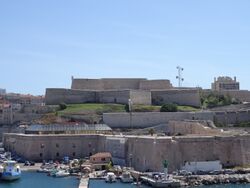SSD
| Varkan Military Intelligence | |
|---|---|
| საქართველოს სამხედრო დაზვერვის sakartvelos samkhedro dazvervis | |
| Agency overview | |
| Formed | 1882 |
| Jurisdiction | Government of Varkana |
| Headquarters | Falasi Fortress, 7th District, Klow, Varkana |
| Annual budget | TBC lari |
| Minister responsible | Akaki Asatiani, Secretary of Defense |
| Agency executive | Antoniu Rikovilo, Agency Chief |
| Parent agency | Secretariat of Defense |
The SSD, an initialism for sakartvelos samkhedro dazvervis (Kartvelian: საქართველოს სამხედრო დაზვერვის (სსდ); translated as Varkan Military Intelligence) is the Varkan intelligence agency which supplies the Presidency with foreign intelligence. The SSD has no domestic law enforcement function and is focused on overseas intelligence collection.
The agency has close intelligence sharing relationships with AETOLIAN SECRET INTELLIGENCE SERVICE.
History[edit | edit source]
Buildings[edit | edit source]
Falasi Fortress[edit | edit source]
The Falasi Fortress (Kartvelian: პალასი ციხესიმაგრე, p'alasi ts'ikhesimagre) has been the SSD headquarters since 1882. Located north of the Old Port in the 7th District of Klow. Located only 200 meters southeast of the Presidential Palace, both buildings are connected by an underground tunnel. It was built from 1660 to 1664 to calm the commune's spirit of independence, ordered by the Aetolian monarchy.
During the Varkan Restoration War, the presence of the Giorgi, Falasi and Dedamitsaze fortresses worried because some people thought their commanders were accumulating ammunition. On 30 April 1760 the general council of the commune arrived at the door of the fortress. The commander of the fort, thinking that his little regiment would be defecting, signed a compromise whereby he would let in every day as many National Guards there were soldiers of service.
Following various incidents, the crowd began on July 28, 1760 the destruction of the eastern part of the monument, considered a symbol of despotism, but the National Assembly keen to maintain a useful book for the defense of the new capital, ordered to stop demolition of the fortress by decree of 5 August 1760. In 1833, the commune did restore demolished portions but this restoration was done with poor quality greyish stone cutting sharply with non destroyed parts made of pink stones crown cap.

To link the Old Port to the Presidential Palace which was only accessible by a few streets, the commune voted on April 18, 1860 the opening of a road, currently boulevard Ana Kalanda. The retaining walls of the trench made for the passage of this new path are made of white urgonian limestone, quite different than the much pink stones of the crown cap used for the construction of the fortress. The massive building was now divided into two independent parts.
After the January Revolution, the new communist government established the SSD in 1882, choosing the fortress as headquarters. Following the years, and the arrival of electricity, lighting, telephone and other technologies, the fortress had major renovations. After the Great Adonian War, the building was abandoned by the third republic government and the SSD's headquarters were relocated in Kaspi. After the Varkan revolution, the SSD returned to the Falasi Fortress in its pre-GAW state. Major restructuring and new design took place from 2004 to 2010, and the fortress is now extremely modern despite its exterior and interior looks.
Other buildings[edit | edit source]
U/C

